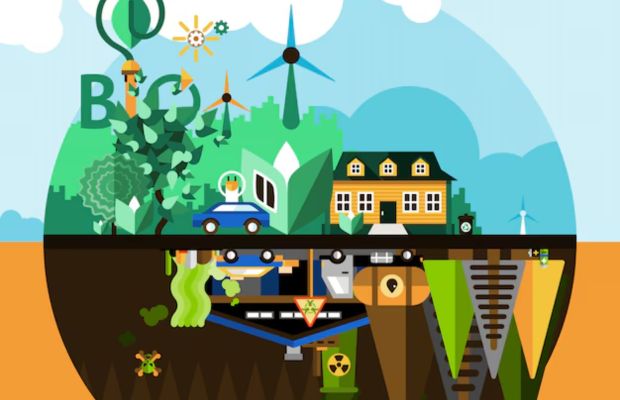Cultivating A Thriving Biofuel Ecosystem: What It Takes To Fuel India’s Green Future
 Cultivating A Thriving Biofuel Ecosystem: What It Takes To Fuel India’s Green Future
Cultivating A Thriving Biofuel Ecosystem: What It Takes To Fuel India’s Green Future
By-Nipun OS
India’s energy goals for the next two decades are threefold: achieve energy security, ensure equitable energy access to drive socio-economic growth, and decarbonize across sectors to combat climate change. Balancing the energy needs of a growing nation with environmental concerns has never been more crucial, and biofuels are uniquely positioned to contribute to these objectives.
As a mature low-carbon energy source, biofuels have existed in the Indian energy policy vocabulary for over 20 years, yet their potential remains largely untapped. We explore why biofuels are pivotal for India’s sustainable future and the steps needed to foster an ecosystem conducive to their development and widespread adoption.
Why biofuels?
India’s decarbonization over the next decade hinges on transitioning to low-carbon sources in power, mobility, and industry—the sectors responsible for 70% of emissions, according to TERI. Electrification is advancing in passenger vehicles and solar energy leads the power sector’s transition.
However, “difficult-to-decarbonize” industries, heavy-duty vehicles, and expanding transport sectors like railways and airlines lack comprehensive solutions. The International Energy Agency’s (IEA) projections show road transport energy demand doubling by 2040, with diesel freight driving over half this growth. Bioenergy offers a significant solution, with the potential to reduce emissions across sectors like power, long-haul transport, manufacturing, heavy industries, and even aviation.
Bioenergy encompasses three forms: liquid biofuels (ethanol, FAME, and Sustainable Aviation Fuel) used in transportation; biogas (from anaerobic digestion or gasification) used for heat, power, and as a fossil fuel replacement in vehicles in the form of compressed biogas (CBG); and solid biomass, primarily for heat and power generation.
Liquid biofuels and biogas, being “drop-in” fuels, integrate seamlessly into existing infrastructure and can slash well-to-wheel emissions by up to 80% compared to fossil fuels, according to India’s Ministry of New and Renewable Energy (MNRE).
Apart from being a renewable, sustainable energy source, bioenergy also promotes circularity by repurposing agricultural and municipal waste, and delivers socioeconomic benefits by assuring farmers an added revenue stream.
Biogas manufacturing, much like open-source tech, thrives on building upon existing technologies and shared knowledge. There is a wealth of publicly available information on digester designs, feedstock choices, and process optimization techniques, which allows for adapting existing technologies to local contexts. This democratisation of information means diverse stakeholders – from small-scale farmers to large industrial plants – can engage in the bioenergy value chain and actively contribute to India’s energy transition story.
A thriving biofuels ecosystem can transform India’s energy landscape, prove that economic growth can coexist with emissions cuts, and set an example for other energy-hungry emerging economies. The IEA predicts that with such an ecosystem, bioenergy could meet 15% of India’s total energy demand by 2040.
To cultivate this ecosystem, all relevant stakeholders – farmers, feedstock providers, policy makers, financial institutes, oil marketing and biofuel companies – must come together and focus on key areas, namely: supply chain development, investment incentives and policy interventions to address key barriers.
Supply chain development
The first step to cultivating a thriving biofuels ecosystem is to develop a robust supply chain that ensures feedstock certainties for producers in the long-run.
Biofuels are categorised into three generations based on the feedstock used to produce them: first-generation (1G), derived from food crops like sugarcane and corn; second-generation (2G) that use non-food sources like agricultural residues, energy crops, and municipal waste; and third-generation (3G), produced from microalgae and bacteria. The production and use of 1G biofuels have raised concerns about competition with food production, pressure on land resources, and potential deforestation caused by increased agricultural land demand. From a life-cycle emissions assessment perspective, 1G biofuels’ GHG emission reduction over fossil fuels is miniscule.
Second-generation biofuels, made from organic waste and non-edible crops, offer a more sustainable alternative by reducing concerns over land use and food security. They provide a solution for waste management and create additional income opportunities for farmers. Although not all types of 2G biofuels are commercially viable yet, biogas production has already demonstrated its effectiveness and potential. However, developing the supply chain requires focusing on the currently underdeveloped areas of aggregating agricultural residues and municipal solid waste.
India’s vast agricultural output offers a prime opportunity for 2G biofuel development, especially by utilising agricultural residues like paddy straw. However, collecting and transporting these resources from small farms to biogas plants poses significant logistical hurdles caused by limited financial resources with farmers and the lack of efficient collection mechanisms.
Adding to the problem is the short harvest-sowing window faced by farmers. As a result, 92 million tonnes of the 500 million tonnes of agri-residue generated annually are burned in fields, contributing significantly to air pollution. Further, infrastructural deficiencies, particularly the lack of decentralised storage or sorting facilities, necessitate direct and costly transportation of waste to plants, adding further delays and expenses.
India also faces a massive waste management challenge, generating about 160,000 tonnes of municipal solid waste daily, according to the Central Pollution Control Board. Landfills, where much of this waste ends up, are super-emitters of methane, a potent greenhouse gas. By 2031, India’s garbage output is projected to reach 125 million tonnes annually, according to an assessment by the Indian Council for Research on International Economic Relations.
Local municipal bodies must equip citizens to source-segregate their organic wastes, which is the first consideration to generate energy from municipal solid waste. The CPCB says only 14 states/UTs currently collect 100% of solid waste, and only two states/UTs (Chhattisgarh & Andaman and Nicibar) practise 100% segregation of waste. More efficient processes to transfer waste from landfills to biogas plants are also needed.
Key barriers and policy interventions
Market analyses and academic studies have described how financial and market risks coupled with regulatory uncertainties discourage private investment and tends to hinder the growth of the sector:
- Financial: High upfront costs, limited access to long-term financing, and high interest rates deter private investment. The lack of proven commercial-scale technologies for diverse waste streams adds to financial risk.
- Market: Biogas-based energy struggles to compete with cheaper sources like coal and other subsidised renewables. Challenges in selling organic fertiliser and competition from other waste treatment methods also exist.
- Regulatory & institutional: Not enough incentives, such as feed-in tariffs or renewable purchase obligations, creates uncertainty for investors. Inefficient waste collection and inconsistent supply chains add to the project risks, often borne solely by private entities.
- Technical & infrastructural: Lack of waste segregation at the source leads to lower quality feedstock and higher processing costs. Inadequate waste collection and transportation infrastructure disrupt the supply chain.
Addressing these challenges will require a multi-pronged approach, including financial incentives, supportive policies, infrastructure development, and technological innovation.
The Sustainable Alternative Towards Affordable Transportation (SATAT) scheme, introduced by the Indian government in 2018 to develop a compressed biogas (CBG) ecosystem, has resulted in 46 plants being commissioned as of 2023. Experts believe the scheme can be even more successful with a focus easing the approval process – CBG plants need various approvals from the Centre, states, and local administration, delaying implementation. Further, CBG pricing needs to be remunerative to manufacturing and marketing companies. It is currently pegged with CNG prices and does not account for the costs of various types of feedstocks or for the environmental benefits.
Infrastructure investments are also needed to improve farmers’ access to residue collection machinery. The Central Government’s Crop Residue Management Guidelines, though yet to be notified, offer a potential solution. Direct incentives, like Haryana’s Rs1,000/tonne subsidy for biomass collection, can encourage farmer participation.
Beyond feedstock, funding R&D on 2G biofuel is vital and expanding existing schemes like the Pradhan Mantri JI-VAN Yojana and leveraging international funding can accelerate development.
Finally, specific policy instruments may be explored to attract consumers, for instance, subsidising the purchase of gas-powered automobiles by vehicle owners.
India’s future hinges on affordable, clean, and reliable energy. Biofuels will play a key role in driving this transition, meeting the scale of India’s growing energy needs and infrastructure development. The nation’s energy choices will profoundly affect its citizens and have ripple effects across the globe, impacting energy markets, emissions, and the flow of technology and capital.
Nipun OS is the Chief Sustainability Officer at GPS Renewables




